How To Cook Spaghetti Squash – 5 Methods
This post may contain affiliate links. Please read my disclosure policy.
Learning how to cook spaghetti squash can be a daunting task initially, but with these five easy methods, you’ll be an expert in no time at all!
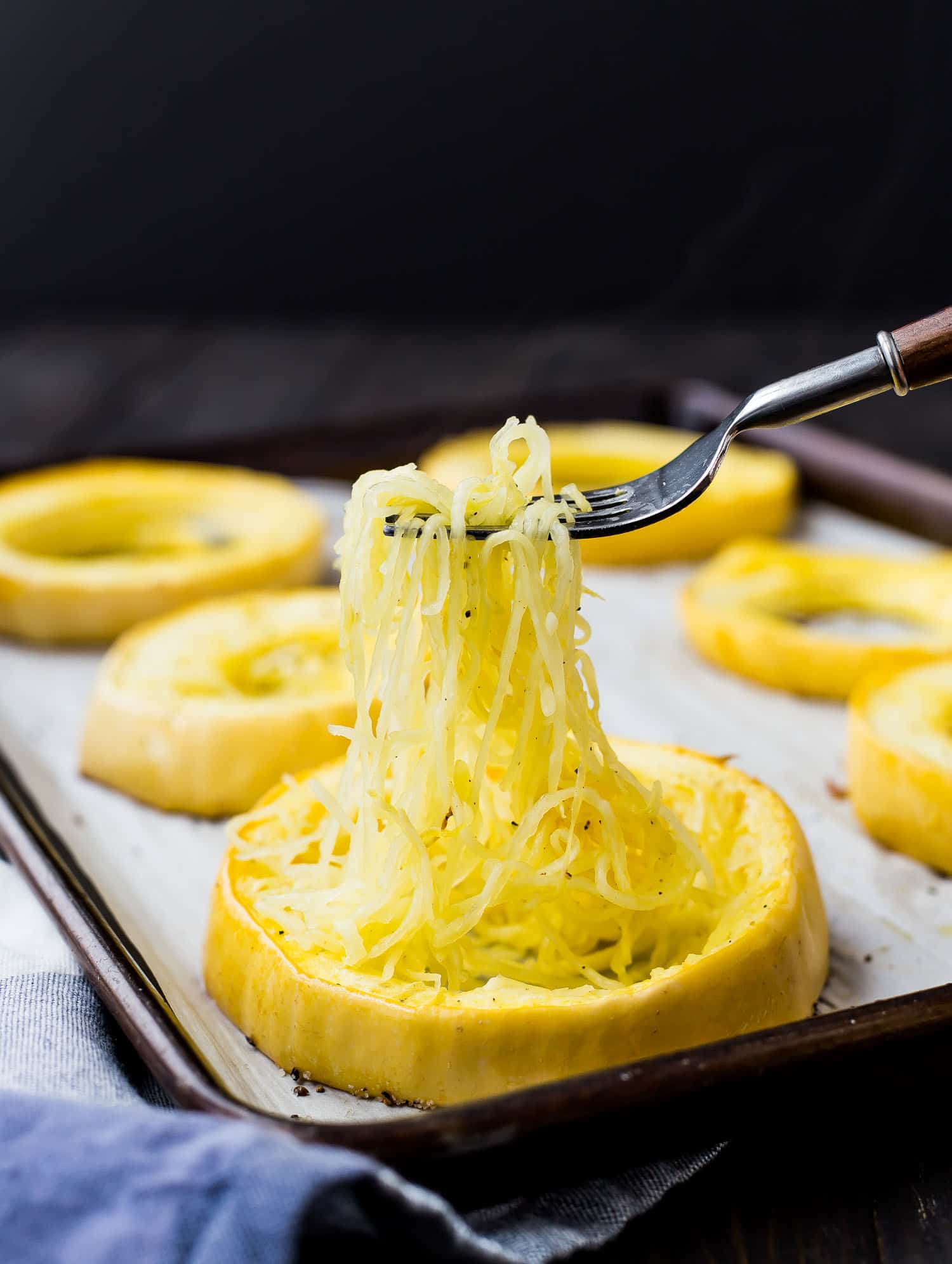
After the huge success of my guide on how to cook acorn squash, I knew I had to bring you this guide for spaghetti squash. It can be a little more daunting since it’s not like all other squash varieties, so we’re going to go through it step-by-step!
Tip: If you love squash like we do, make sure to also check out my tutorials on butternut squash, kabocha squash, and delicata squash!
Overview
My favorite way is also the most labor intensive, which is why I cover all of these different ways. You can make the decision based on what’s best for you today:
- Do you need it to be hands-off and cook slowly in the slow cooker while you work or run errands? The slow cooker method is for you.
- Do you need it done fast? Use your Instant Pot.
- If you have a little more time, try the oven methods!
Also in this post are serving suggestions and storing recommendations. Once you learn how to cook spaghetti squash, you’re going to be making it all the time!
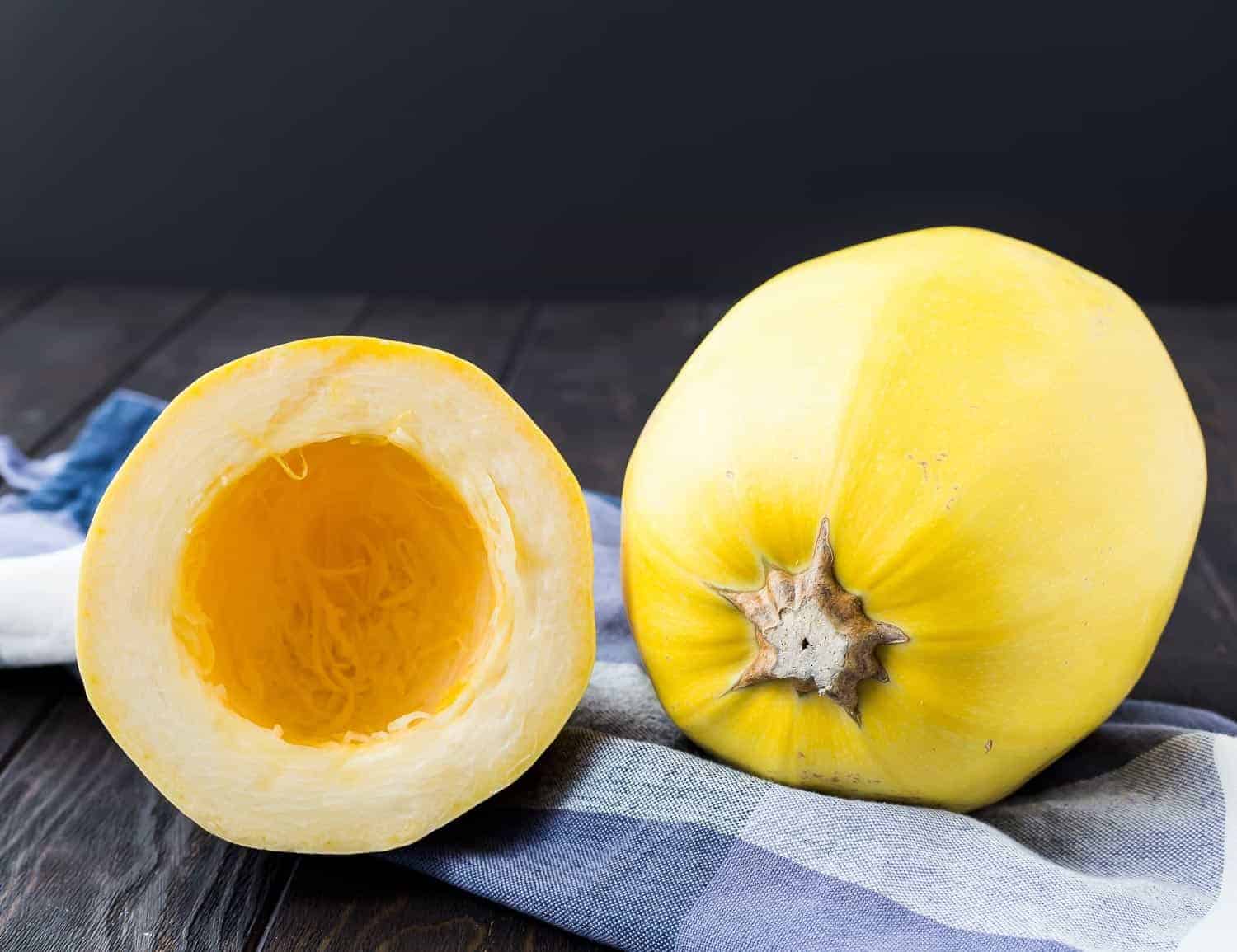
FAQs
Yes, you can. It may be a little tricky, depending on the size of your microwave oven. Cut the squash in half, and place cut side down in a baking dish with about an inch of water.
Microwave on high power for 10-15 minutes, or until soft. Cook time will depend on how large your squash is.
None of the five methods here require peeling the squash, but you probably don’t want to eat the peel as it is quite tough.
Squash is very hard to cut through, so here’s a little tip. Poke some holes in it with a sharp knife (this is to release pressure), and then microwave for 3-5 minutes. Let cool, and then cut. Microwaving the squash softens the peel and makes it easier to slice through.
Unfortunately, overcooked spaghetti squash can be mushy and watery, so keep an eye on it while it’s cooking. You want it to be soft, but not mushy. Some crispness in the strands will lead to a more enjoyable experience.
This is an easy fix! You can return to your preferred cooking method and just cook it a little longer. Five to ten more minutes in the oven might be all it needs. If you were using the pressure cooker method, you could cook it again for 3-5 minutes (remember it will take some time to come to pressure again. If you were using the slow cooker method and don’t want to wait another hour or two, try popping it in the microwave (see above microwave directions), or switch to the baking method.
Five Ways to Cook Spaghetti Squash
Each of these ways is completely effective and has its own pros and cons. My personal favorite is cutting it into rings and baking it. That method prevents the squash from steaming and becoming watery. It yields the pretty, spaghetti-like strands that you see in these photos. This method also allows you to season the squash, which is always a good thing!
As always, the printable instructions can be found if you scroll down to the recipe card!
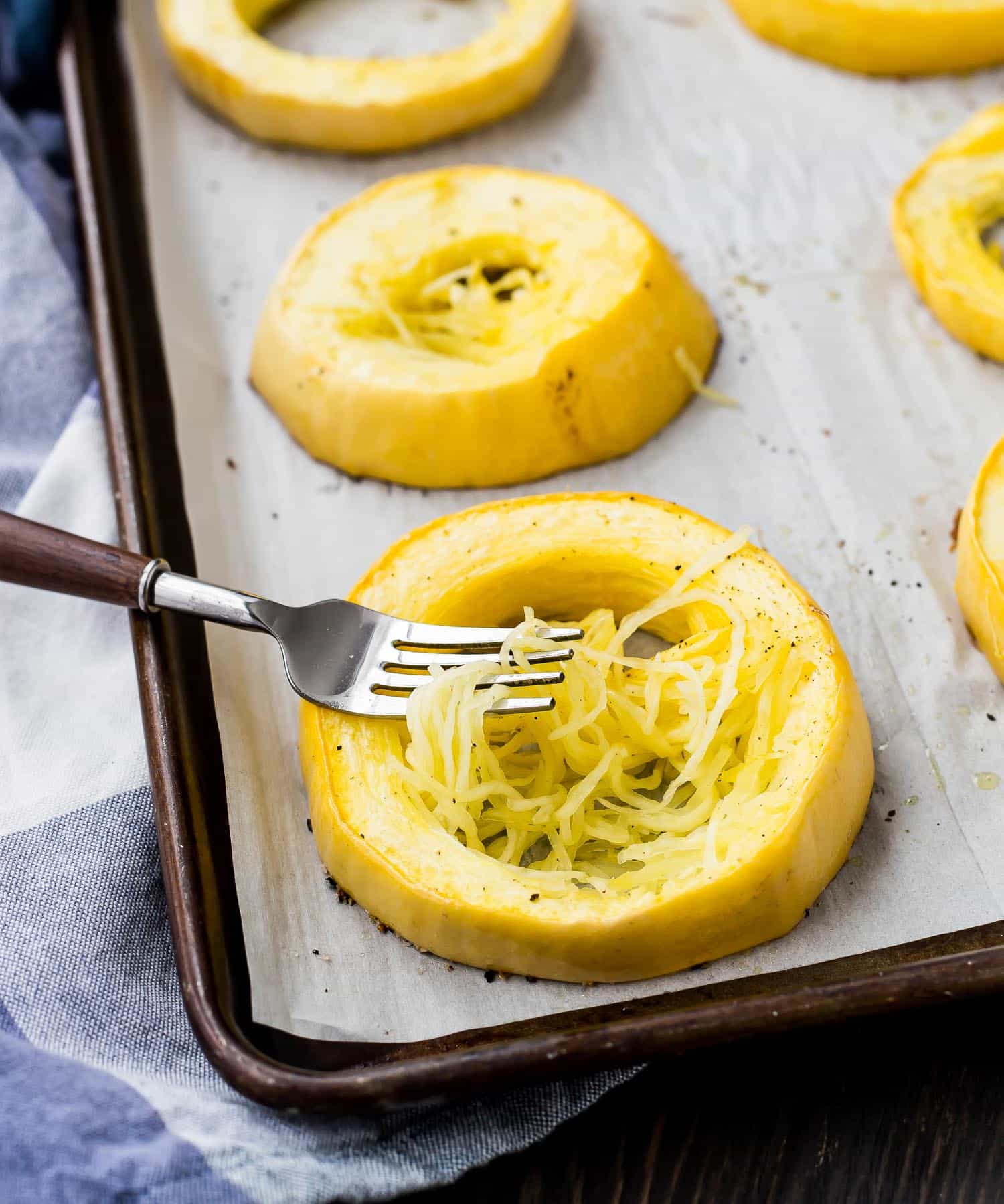
Baking Spaghetti Squash in Rings
This is my preferred method, provided I have the time and energy to slice the squash into rings.
- Pros: This method yields perfect strands of spaghetti squash every time and won’t leave you with soggy “noodles.”
- Cons: The prep for this method is more labor intensive and a little trickier, be careful with your knife!
Baking Whole Spaghetti Squash
This method is quite straightforward and arguably the most well-known method of cooking squash.
- Pros: It doesn’t get much easier than this!
- Cons: The squash steams on the inside, yielding softer, more watery spaghetti squash.
Baking Spaghetti Squash Halves
If I don’t feel like messing with the rings, this is always my next option and the method I use to cook many types of squash.
- Pros: Super easy, since there is only one cut to make.
- Cons: Slightly soggier squash than with the ring method.
Spaghetti Squash in the Instant Pot
- Pros: This is the quickest method and requires very little monitoring.
- Cons: Depending on the size of your squash and your pressure cooker, it may not fit. This method also makes the squash very soft, you may find it even falls apart, which makes it harder to get those nice strands of squash out.
A note about this method – I have a 6 quart pressure cooker and my squash was between 3.5 and 4 pounds (if we’re being exact, it was 3.75 pounds). The squash pretty much filled my Instant Pot to capacity, so if you have a 6 quart Instant pot, make sure to keep this in mind when selecting a squash – I wouldn’t go any larger than 3.75 pounds for this cooking method. If you choose a smaller squash, you can decrease cooking time slightly.
Cooking Spaghetti Squash in the Slow Cooker
This method is very similar to using an Instant Pot, but it’s slower…hence the name, slow cooker. You can also cook butternut squash in the slow cooker.
- Pros: Set it and forget it! This is a great method if you plan to be gone for the majority of the day. It also doesn’t require cutting a raw squash, which is nice.
- Cons: Similar to the Instant Pot, this method will make your squash quite soft and it may fall apart, making it harder to remove the seeds and separate the strands.
Serving Suggestions
Spaghetti squash is a blank slate, just like normal spaghetti! You can try it with an easy turkey bolognese to start, but here are some other fun options:
- Vegan Bolognese
- Spaghetti Sauce with loads of tomatoes and basil, slow simmered on the stove
- Nut-Free Arugula Pesto
- Tomato Cream Sauce
- Chicken, Spinach, and Lemon Cream Sauce
- Skinny Alfredo Sauce
- Chicken Fajita Stuffed Spaghetti Squash (you can replace the chicken with shrimp, steak, taco meat, or black beans)
- Pizza Stuffed Spaghetti Squash (use your favorite pizza toppings)
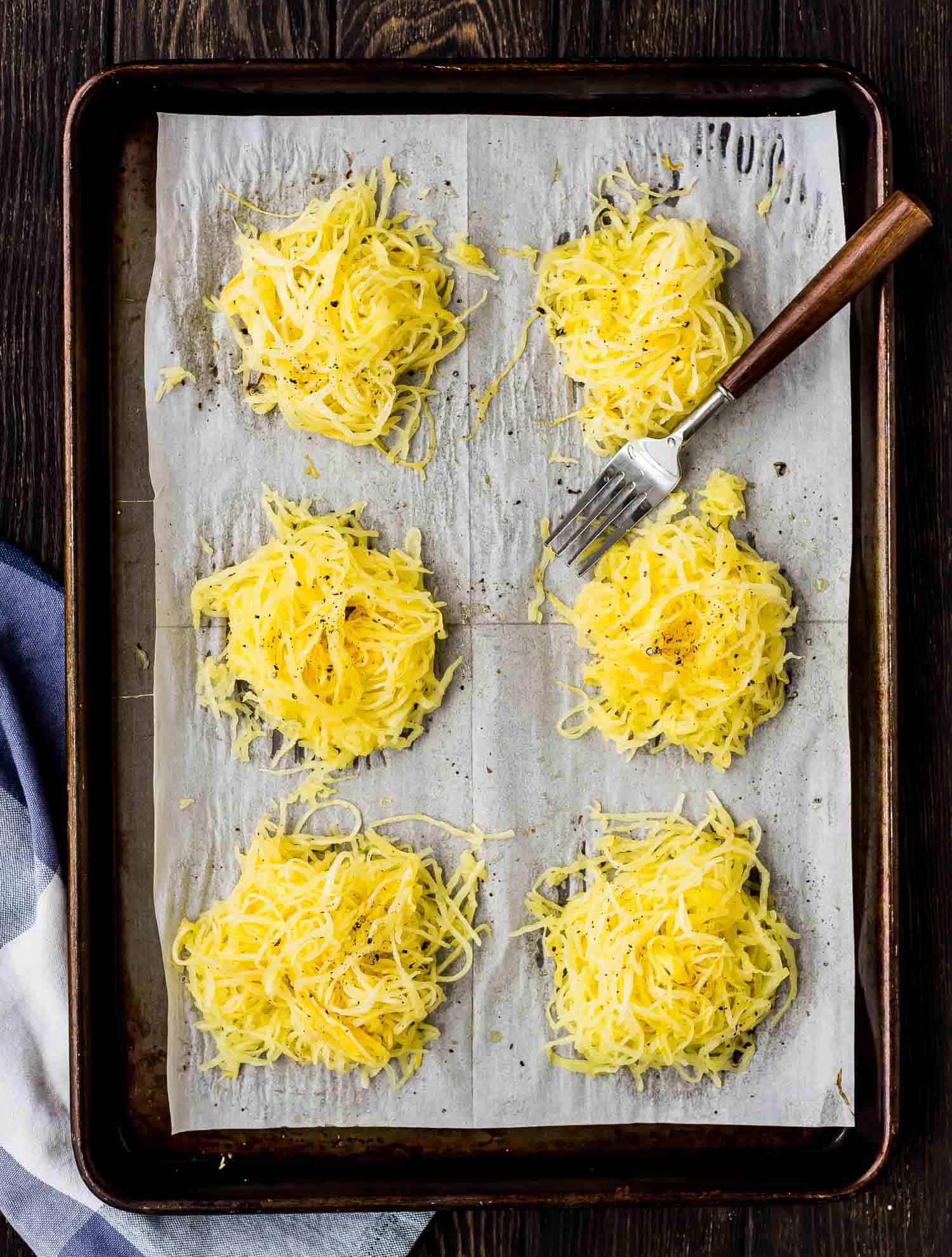
Storage Suggestions
Cooked spaghetti squash will keep for about a week stored in an airtight container in the refrigerator.
Did you make this? Be sure to leave a review below and tag me @rachelcooksblog on Facebook, Instagram, or Pinterest!
Ingredients
- 1 spaghetti squash
- 1-2 tablespoons olive oil (for oven roasting methods)
- salt and pepper (for oven roasting methods)
Instructions
To Cook in Rings in Oven:
- Preheat oven to 400°F.
- Scrub squash clean and CAREFULLY cut into 1-inch rings.
- Scrape out seeds
- Spray or rub squash rings with olive oil, sprinkle with salt and pepper and place in a single layer on a parchment-paper lined baking sheet.
- Bake for 40 minutes or until tender. Let cool slightly before using a fork or your hands to form spaghetti squash strands.
To Cook Whole In Oven:
- Preheat oven to 400°F. Scrub the squash clean. Next, use a knife to prick holes all over the squash.
- Place on a baking sheet and roast at 400°F until tender (poke with a knife to test) — about an hour, depending on how large of a squash you have. Turn the squash over halfway through cooking to ensure even cooking.
- When tender, let cool enough to handle. Cut in half – if you cut it lengthwise (from stem to end), you’ll have shorter spaghetti strands. If you cut it crosswise, you'll have longer strands.
- Remove seeds. Use a fork to separate the squash into strands.
To Cook Cut in Half In Oven:
- Preheat oven to 400°F. Scrub the squash clean.
- Cut in half – if you cut it lengthwise (from stem to end), you’ll have shorter spaghetti strands. If you cut it crosswise, you’ll have longer strands. Scoop out the seeds.
- Drizzle inside lightly with olive oil (use a brush or your hands to evenly coat) and sprinkle with salt and pepper.
- Place the squash cut side down on a parchment paper lined baking sheet. Roast at 400°F until tender (poke with a knife to test) — about an hour, depending on how large of a squash you have.
- When tender, let cool enough to handle. Use a fork to separate the squash into strands.
How to Cook Spaghetti Squash in the Instant Pot
- Scrub squash clean and carefully pierce all over with knife (10-15 cuts, 1/2-inch to 1-inch in size).
- Place steamer basket in the bottom of the pressure cooker and add 1 cup water. Place squash in/on steamer basket.
- Secure lid, turn valve to seal, and set for 20 minutes on high pressure. When timer goes off, quick release pressure by turning the valve to "vent."
- Carefully remove squash and let cool enough to handle. Cut in half – if you cut it lengthwise (from stem to end), you’ll have shorter spaghetti strands. If you cut it crosswise, you’ll have longer strands. Remove seeds. Use a fork to separate the squash into strands.
How to Cook Spaghetti Squash in the Slow Cooker
- Scrub squash clean and carefully pierce all over with a knife (10-15 cuts, 1/2-inch to 1-inch in size).
- Place squash in slow cooker and place the cover on. Cook on high for 3-4 hours or on low for 6-8 hours or until easily pierced with a knife.
- Carefully remove squash and let cool slightly. Cut in half – if you cut it lengthwise (from stem to end), you’ll have shorter spaghetti strands. If you cut it crosswise, you’ll have longer strands. Remove seeds.
- Use a fork to separate the squash into strands.
Notes
- Cooking and prep times will vary depending on which cooking method is used.
- Cooked spaghetti squash will keep for about a week stored in an airtight container in the refrigerator.
- Serving Size: Approximately 1 cup of spaghetti squash. Nutrition details calculated without olive oil.
Nutrition Information
This website provides approximate nutrition information for convenience and as a courtesy only. Nutrition data is gathered primarily from the USDA Food Composition Database, whenever available, or otherwise other online calculators.
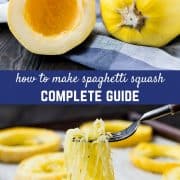
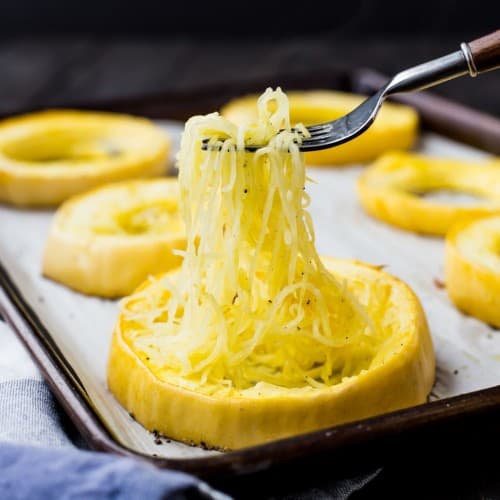
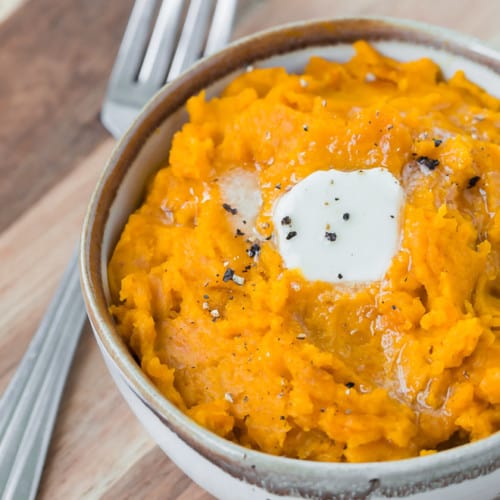
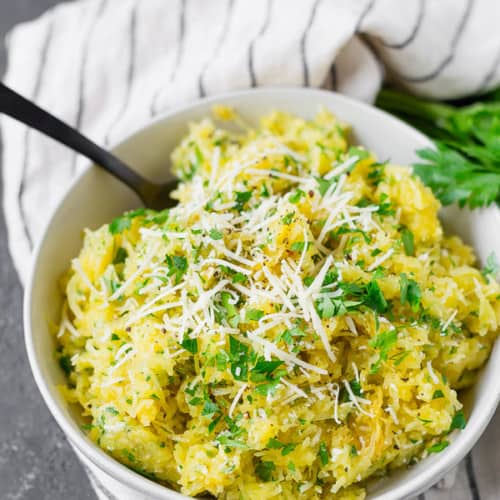
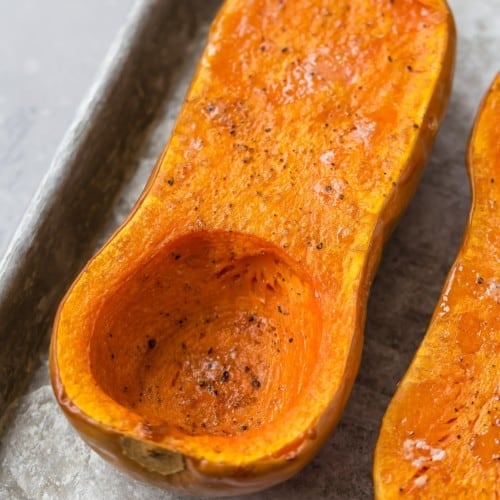
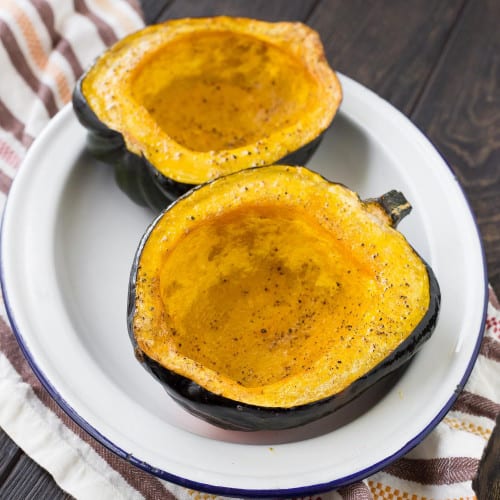
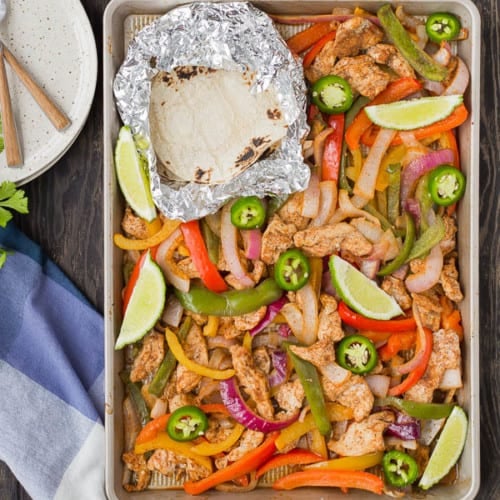

Jessica says
I cooked it by cutting it into rings. Seems like the smaller squashes are easier to do this with. It came out great. After it was fully cooked turned the broiler on and browned it a bit. Topped with some mozzarella cheese and garlic and it was delicious! The only thing I was wondering about was why to scrub the squash clean if we aren’t eating the skin anyway?
Rachel Gurk says
Yum! Love the idea of topping with cheese and garlic! I scrub the squash because when you cut it, the knife goes through the outside (dirty) and into the inside (clean). It’s my personal preference to clean the outside so that dirt doesn’t get brought into the inside.
But that’s just me! If you feel like skipping that step, I won’t judge. ;)
Linda says
Hi. Bacteria and germs from the outside of the squash can get on the flesh of the squash if you don’t wash it first. My mom always scrubbed potatoes for the same reason, so I just scrub everything. Pesticides and fertilizers are also an issue these days, unless you buy organic. That being said – I tried your variation, broiling it an adding cheese and garlic…YUM! Served it with shrimp and everyone kept talking about the gourmet meal I served.
Rachel Gurk says
I’m glad I’m not the only one that scrubs everything! Broiling with cheese and garlic and topping with shrimp sounds SO good! Thanks for taking the time to come back and leave a comment! Means a lot to me. :)
Phil Reynolds says
I made the baked rings for myself exactly as stated sans pepper. I let it cook for roughly 20 mins and it was fantastic! I stored half for another day. The pasta-esque texture and taste were the best veggie pasta I’ve ever made. This is now my top recipe for spaghetti squash. Thank you!
Rachel Gurk says
So happy to hear this was a success for you, Phil! Thanks for taking the time to come back and leave a comment!
Janice Thomas says
I got about a 10-12 pound spaghetti squash. Has anyone cooked one this big and how did they do it?
Rachel Gurk says
I’d prepare it the same way (whichever of the five that you prefer – probably oven methods are best since it may not fit in the pressure cooker or slow cooker) but just increase cooking time as needed to get it to be fork tender.
Lisa says
Cut it into quarters ( much easier than rings) and roasted. Served with toasted with roasted garlic, tomatoes and Brussels sprouts and olive oil. Delicious! Will definitely make again!
Rachel Gurk says
That sounds so delicious! Thanks for taking the time to come back and leave a comment!
Carla Stadtmiller says
The ring method makes wonderfully dry ‘spaghetti ‘ that soaks up the flavor of your favorite sauce. Cutting the squash used to be quite daunting until I headed out to the shop, commandeered a new Sheetrock saw to add to my kitchen tools. A little messy with the squash ‘shavings’ but amazingly easy!
Rachel Gurk says
That’s genius! So glad you like this method, Carla!
Renee Overbeck says
I made the rings and they turned out great!!
Rachel Gurk says
So happy to hear that!
Michelle M says
Thank you for sharing this recipe! I used the cut in half oven-cooked method. It turned great! The only improvement I would make is the texture. I tried to do the ring method, unfortunately I was not physically able to cut the squash this way. I baked the halves for an hour, then raked out the halves to get the spaghetti strands. Next, I spread the strands out on the baking sheet, sprinkled with grated parmesan cheese and baked for an additional 20 minutes. I have also spread out the strands, sprinkled with shredded parmesan cheese and put under the broiler for several minutes. Do you know of anything else I can try to help with the ‘spaghetti’ texture? Either way, I will definitely keep using this recipe. Thanks again!
Rachel Gurk says
Yeah, it can be super difficult to cut into rings…sorry it didn’t work for you to do it that way! Did you cut it in half right down the middle (the short way) vs end to end? That helps with getting the longer strands because of the way they grow around the squash. That’s the best tip I have, naturally it’s just a little more mushy when it’s baked that way. I bet it was tasty the way you did it, did it get a little crispy? I want to give that a try!
Tina Hatfield says
I cooked this using the rings in the oven method. I used spray oil, garlic salt and pepper. I also flipped them over half way through the cooking time, sprayed and seasoned and then let them finish cooking. I used some noodles with a meat marinara sauce and put the rest in the fridge for alfredo in a few days. However, the noodles were so good and the texture just right, that my daughter and I had just the noodles with no sauce.
Rachel Gurk says
This makes me so happy! I’m so glad you liked this method – thanks for taking the time to come back and leave a comment!
David McElroy says
Thank you for the recipe! I have cooked spaghetti squash many times with other methods, but I definitely liked this the best.
Rachel Gurk says
That’s great! I’m so glad this method worked for you! Thanks for taking the time to come back and leave a comment!
Susan Billups says
I really like the recipe. It looks really delicious and easy to make.
Rachel Gurk says
So happy to hear that, thanks Susan!
Mary Beth Tolman says
I tried the circle cut idea and baked it in my toaster oven. I used Hojibianca olive oil. I needed to warm my sauce but after tasting, I didn’t want to wait. Much nicer texture then cooking half or whole. Thanks Rachel.
Rachel Gurk says
I’m so glad this method worked for you! Thanks for taking the time to come back and leave a comment!
Carla says
Made it in rings for the first time today, served with meat sauce. Delicious! Thanks for your helpful tips!
Rachel Gurk says
Hi Carla! Thanks for taking the time to come back and leave a comment! I’m so glad this method worked for you and you liked it!
J.M. Cornwell says
One of my favorite diet meals. Always a winner. Now I know how to cook it & not just order it. Have to try the rings. Maybe convert family.
Rachel Gurk says
I hope you love the rings! It’s the most labor intensive method but the most similar to pasta. We love it!
Cheri L says
If someone can tell me how to cut it rings without making a disaster it would be appreicated. I can’t cut them without the rings being totally lopsided…
Rachel Gurk says
It can be super tricky! Try cooking it in the microwave for 3-4 minutes and letting it cool completely first. This softens the skin slightly and makes it a little easier. You could also take a thin slice off one side of the skin to make a flatter surface so it doesn’t roll around as much.
C says
I used an electric knife for meat/bread cutting and worked great.
Rachel Gurk says
That’s genius! Thanks for the tip!
Noralee Hughes says
I used a serrated knife to score the tough peel then my heavy chef knife to finish cutting through the rings.
Rachel Gurk says
What a great idea! Thanks for the tip!
Baxter says
This looks absolutely delicious.. have to try it!
Rachel Gurk says
I hope you love it!
Denise says
the “ring” method is something I’ve never thought of
Rachel Gurk says
It’s unique but I love the way it turns out when you cook it that way!